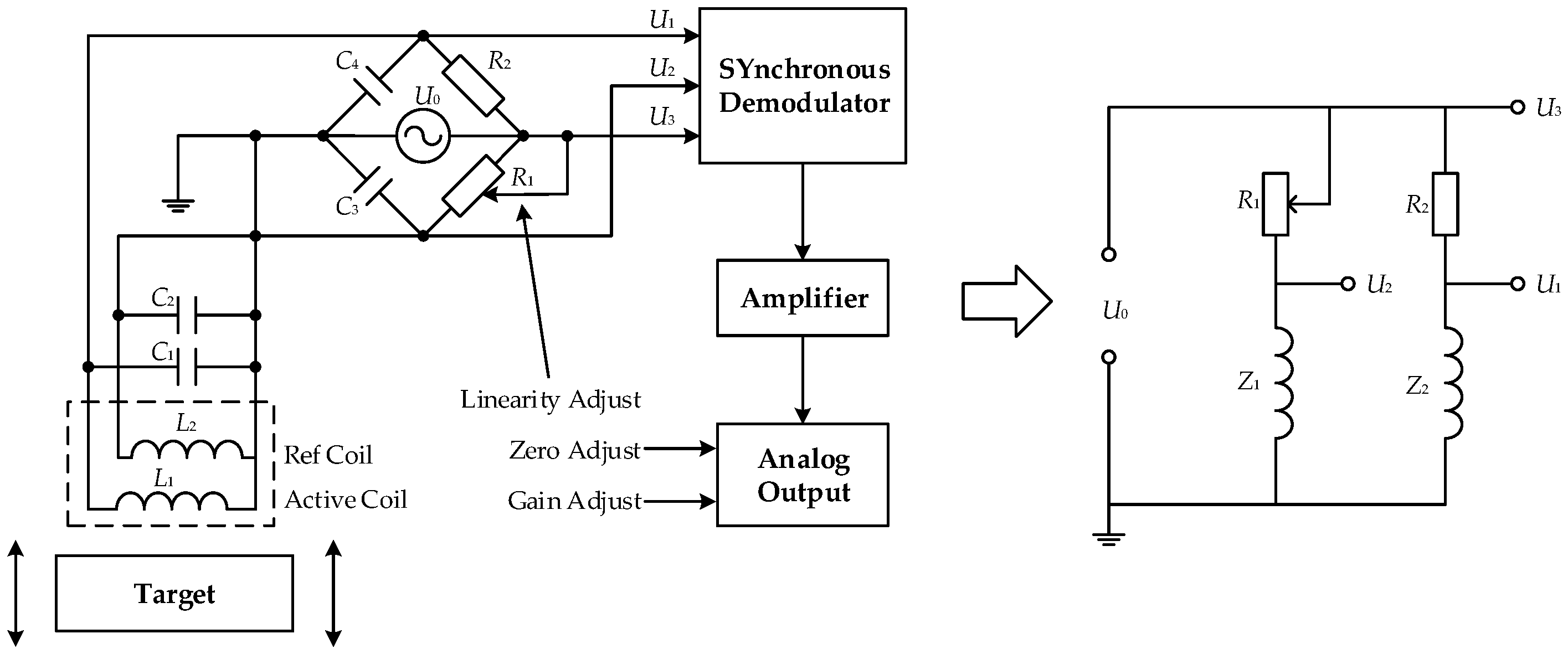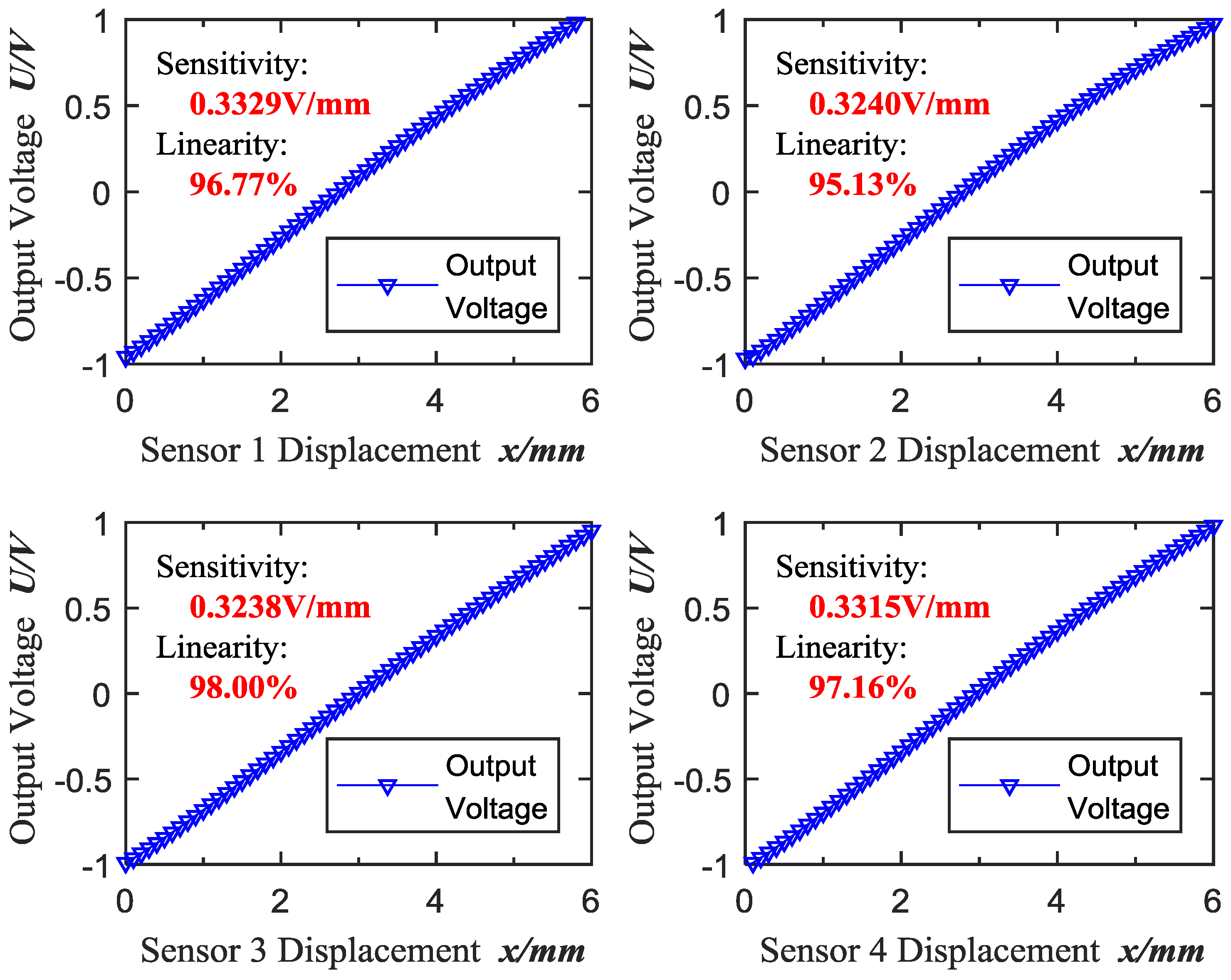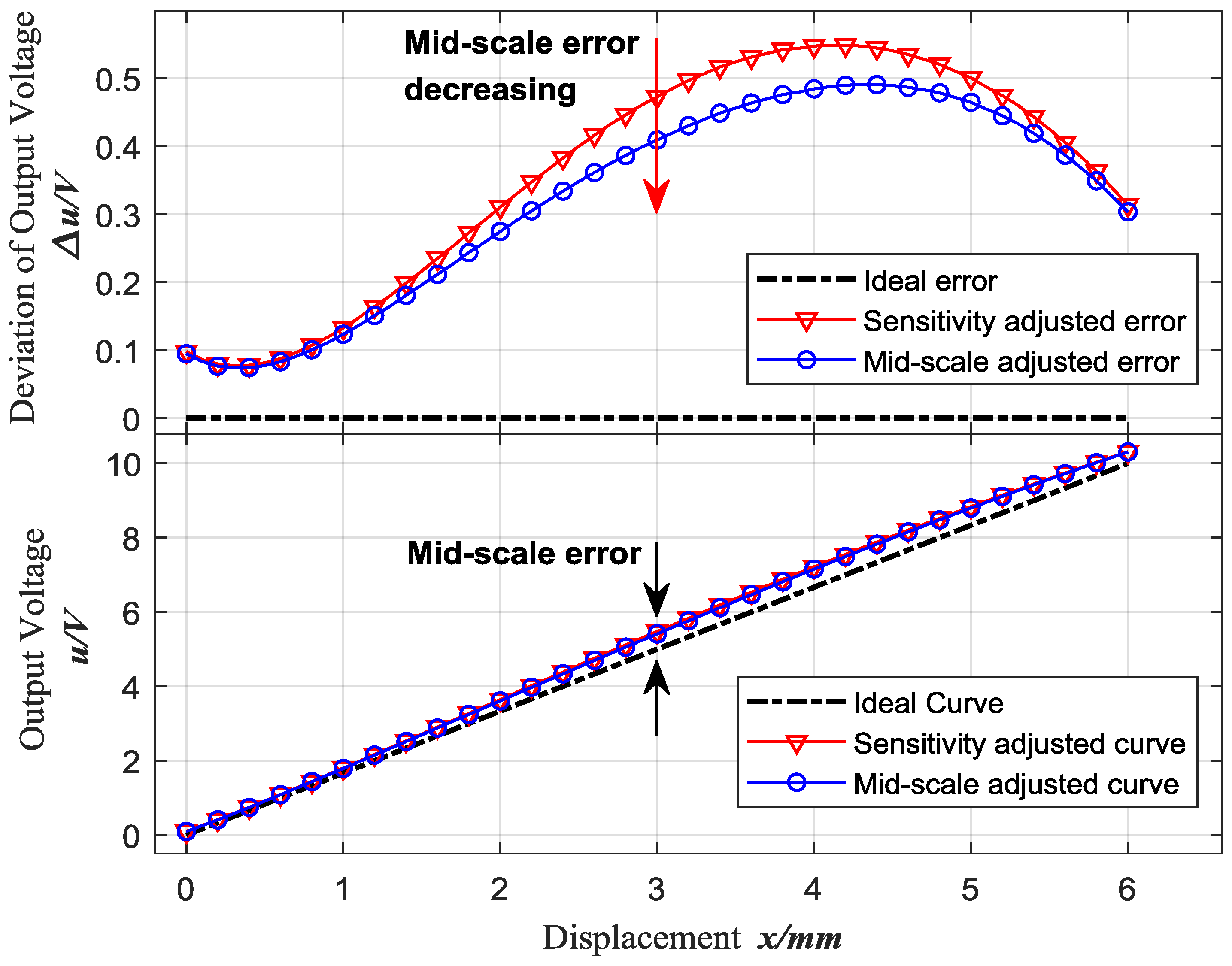High-Accuracy Calibration Based on Linearity Adjustment for Eddy Current Displacement Sensor
Abstract
:1. Introduction
2. Original Output Characteristics Test
2.1. Relational Model of Displacement and Acquisition Voltage
2.2. Sensitivity and Linearity Test
3. Calibration Method Based on Linearity Adjustment Model
3.1. Sensitivity Adjustment Function
3.2. Mid-Scale Adjustment Function
3.3. Zero-Scale and Full-Scale Adjustment Function
3.4. Overall Adjustment Model
4. Calibration Accuracy Verification
4.1. Equidistance Displacement Error Verification
4.2. Accumulated Displacement Error Verification
5. Conclusions
Author Contributions
Acknowledgments
Conflicts of Interest
References
- Chaturvedi, V.; Nabavi, M.R.; Vogel, J.; Nihtianov, S. Demodulation techniques for self-oscillating dddy-current displacement sensor interfaces: A review. IEEE Sens. J. 2017, 17, 2617–2624. [Google Scholar] [CrossRef]
- Hensel, S.; Strauβ, T.; Marinov, M. Eddy current sensor based velocity and distance estimation in rail vehicles. IET Sci. Meas. Technol. 2015, 9, 875–881. [Google Scholar] [CrossRef]
- Bai, G.; Liu, J.; Song, Y.; Zuo, Y. Two-UAV intersection localization system based on the airborne optoelectronic platform. Sensors 2017, 17, 98. [Google Scholar] [CrossRef] [PubMed]
- Wang, Z.; Mastrogiacomo, L.; Franceschini, F.; Maropoulos, P. Experimental comparison of dynamic tracking performance of iGPS and laser tracker. Int. J. Adv. Manuf. Technol. 2011, 56, 205–213. [Google Scholar] [CrossRef] [Green Version]
- Yu, Y.; Yang, T.; Du, P. A new eddy current displacement measuring instrument independent of sample electromagnetic properties. NDT E Int. 2012, 48, 16–22. [Google Scholar]
- Chang, H.K.; Kim, J.H.; Kim, I.H.; Dong, Y.J.; Han, D.C. In-process surface roughness prediction using displacement signals from spindle motion. Int. J. Mach. Tools Manuf. 2007, 47, 1021–1026. [Google Scholar] [CrossRef]
- Jeong, G.B.; Kim, D.H.; Jang, D.Y. Real time monitoring and diagnosis system development in turning through measuring a roundness error based on three-point method. Int. J. Mach. Tools Manuf. 2005, 45, 1494–1503. [Google Scholar] [CrossRef]
- Fang, J.; Wen, T. A wide linear range eddy current displacement sensor equipped with dual-coil probe applied in the magnetic suspension flywheel. Sensors 2012, 12, 10693–10706. [Google Scholar] [CrossRef] [PubMed]
- Ricci, M.; Silipigni, G.; Ferrigno, L.; Laracca, M.; Adewale, I.D.; Gui, Y.T. Evaluation of the lift-off robustness of eddy current imaging techniques. NDT E Int. 2017, 85, 43–52. [Google Scholar] [CrossRef]
- Tian, G.Y.; Zhao, Z.X.; Baines, R.W. The research of inhomogeneity in eddy current sensors. Sens. Actuators A Phys. 1998, 69, 148–151. [Google Scholar] [CrossRef]
- Nihtianov, S. Measuring in the subnanometer range: Capacitive and eddy current nanodisplacement sensors. IEEE Ind. Electron. Mag. 2014, 8, 6–15. [Google Scholar] [CrossRef]
- Tseng, V.F.G.; Xie, H. Simultaneous piston position and tilt angle sensing for large vertical displacement micromirrors by frequency detection inductive sensing. Appl. Phys. Lett. 2015, 107, 148. [Google Scholar] [CrossRef]
- Tseng, F.G.; Xie, H. Resonant inductive coupling-based piston position sensing Mechanism for large vertical displacement micromirrors. J. Microelectromech. Syst. 2016, 25, 207–216. [Google Scholar] [CrossRef]
- Measurement of Mirror Tilting. Available online: https://www.micro-epsilon.com/applications/branch/aerospace-raumfahrt/Spiegelverkippung/ (accessed on 15 June 2018).
- Detection of Turbocharger Rotor Dynamics. Available online: https://www.micro-epsilon.com/applications/areas/Spalt/Rotordynamik-am-Turbolader/ (accessed on 15 June 2018).
- Nabavi, M.R.; Nihtianov, S. Eddy-current sensor interface for advanced industrial applications. IEEE Trans. Ind. Electron. 2011, 58, 4414–4423. [Google Scholar] [CrossRef]
- KejíK, P.; Kluser, C.; Bischofberger, R.; Popovic, R.S. A low-cost inductive proximity sensor for industrial applications. Sens. Actuators A Phys. 2004, 110, 93–97. [Google Scholar]
- Oberle, M.; Reutemann, R.; Hertle, R.; Huang, Q. A 10-mW two-channel fully integrated system-on-chip for eddy-current position sensing [in biomedical devices]. IEEE J. Solid State Circuits 2002, 37, 916–925. [Google Scholar] [CrossRef]
- Qu, Z.; Zhao, Q.; Meng, Y. Improvement of sensitivity of eddy current sensors for nano-scale thickness measurement of Cu films. NDT E Int. 2014, 61, 53–57. [Google Scholar] [CrossRef]
- Nabavi, M.R.; Nihtianov, S.N. Design strategies for eddy-current displacement sensor systems: Review and recommendations. IEEE Sens. J. 2012, 12, 3346–3355. [Google Scholar] [CrossRef]
- Vyroubal, D.; Lacković, I. Target temperature effect on eddy-current displacement sensing. In Proceedings of the IEEE Sensors Applications Symposium (SAS 2015), Zadar, Croatia, 13–15 April 2015; pp. 1–5. [Google Scholar]
- Vogel, J.G.; Chaturvedi, V.; Nihtianov, S. Eddy-current sensing principle in inertial sensors. IEEE Sens. Lett. 2017, 1, 1–4. [Google Scholar] [CrossRef]
- Sasi, B.; Arjun, V.; Mukhopadhyay, C.K.; Rao, B.P.C. Enhanced detection of deep seated flaws in 316 stainless steel plates using integrated EC-GMR sensor. Sens. Actuators A Phys. 2018, 275, 44–50. [Google Scholar]
- Ding, X.; Chen, X.; Ma, W.; Chen, X.; Li, N. A novel PQCR-L circuit for inductive sensing and its application in displacement detection. IEEE Trans. Instrum. Meas. 2016, 65, 685–693. [Google Scholar] [CrossRef]
- Zhang, H.S.; Cao, X.K.; Guo, B.; Wang, Q.; Fu, Y.H. An approach of eddy current sensor calibration in state estimation for maglev system. In Proceedings of the International Conference on Electrical Machines and Systems (ICEMS 2007), Seoul, Korea, 8–11 October 2007; pp. 1955–1958. [Google Scholar]
- Clough, D.; Fletcher, S.; Longstaff, A.P.; Willoughby, P. Practical in situ calibration method for the nonlinear output from a low cost eddy current sensor. In Proceedings of the 37th International Matador Conference (IMC 2012), Manchester, UK, 25–27 July 2012; pp. 281–284. [Google Scholar]
- Babu, A.; George, B. Design and development of a new non-contact inductive displacement sensor. IEEE Sens. J. 2018, 18, 976–984. [Google Scholar] [CrossRef]
- Babu, A.; George, B. A wide range planar coil based displacement sensor with high sensitivity. In Proceedings of the IEEE International Instrumentation and Measurement Technology Conference (I2MTC 2017), Politecnico di Torino, Italy, 22–27 May 2017; pp. 1–6. [Google Scholar]
- Kolts, B.S. Understanding linearity and monotonicity. Foreign Electron. Meas. Technol. 2014, 24, 30–31. [Google Scholar]
- He, Y.; Pan, M.; Luo, F.; Chen, D.; Hu, X. Support vector machine and optimised feature extraction in integrated eddy current instrument. Measurement 2013, 46, 764–774. [Google Scholar] [CrossRef]
- Cui, J.; Wang, Y. A novel approach of analog circuit fault diagnosis using support vector machines classifier. Measurement 2011, 44, 281–289. [Google Scholar] [CrossRef]













| Sensor 1 | Sensor 2 | Sensor 3 | Sensor 4 | |
|---|---|---|---|---|
| Output range (V) | −0.9593–1.038 | −0.9682–0.9760 | −0.9906–0.9522 | −1.0075–0.9813 |
| Sensitivity (V/mm) | 0.3329 | 0.3240 | 0.3238 | 0.3315 |
| Linearity | 96.77% | 95.13% | 98.00% | 97.16% |
| Sensor 1 | Sensor 2 | Sensor 3 | Sensor 4 | |
|---|---|---|---|---|
| Adjusted Output Range (V) | 0.098–10.3139 | −0.103–9.7036 | −0.1100–9.8800 | −0.0852–10.3420 |
| Original Sensitivity (V/mm) | 0.3329 | 0.3240 | 0.3238 | 0.3315 |
| Adjusted Sensitivity (V/mm) | 1.7026 | 1.6344 | 1.6650 | 1.7379 |
| Sensor 1 | Sensor 2 | Sensor 3 | Sensor 4 | |
|---|---|---|---|---|
| Number of Loops | 7 | 15 | 12 | 8 |
| Output Range (V) | 0.0286–10.0916 | −0.0073–9.9788 | −0.0133–9.9855 | −0.0209–10.0837 |
| Sensitivity (V/mm) | 1.6772 | 1.6644 | 1.6665 | 1.6841 |
| Linearity (before adjustment) | 96.77% | 95.13% | 98.00% | 97.16% |
| Linearity (after adjustment) | 99.91% | 99.90% | 99.91% | 99.92% |
| Linearity increase | 3.2% | 5.0% | 1.9% | 2.8% |
| Minimum | Maximum | Average of EDE Absolute Value | Standard Deviation of EDE Absolute Value | |
|---|---|---|---|---|
| Sensor 1 | −1.81/−0.87 | 3.18/0.76 | 1.18/0.29 | 0.89/0.26 |
| Sensor 2 | −1.89/−0.62 | 4.39/0.69 | 1.43/0.29 | 1.26/0.19 |
| Sensor 3 | −2.33/−0.38 | 4.44/0.76 | 1.86/0.27 | 1.20/0.20 |
| Sensor 4 | −1.99/−0.82 | 4.77/1.46 | 2.06/0.52 | 1.54/0.38 |
| Minimum | Maximum | Median | Error Fluctuation Range | |||||
|---|---|---|---|---|---|---|---|---|
| Before | After | Before | After | Before | After | Before | After | |
| Sensor 1 | −1.5738 | 0.0151 | 11.7100 | 3.6448 | 8.0314 | 2.2914 | 13.2838 | 3.6297 |
| Sensor 2 | 2.6729 | −0.1753 | 17.5170 | 0.9299 | 11.9520 | 0.3472 | 14.8441 | 1.1052 |
| Sensor 3 | −2.3386 | 0.3509 | 15.1110 | 2.5863 | 8.4100 | 2.0165 | 17.4496 | 2.2354 |
| Sensor 4 | 0.3548 | 1.4598 | 24.7550 | 9.0554 | 17.6790 | 6.7096 | 24.4002 | 7.5956 |
© 2018 by the authors. Licensee MDPI, Basel, Switzerland. This article is an open access article distributed under the terms and conditions of the Creative Commons Attribution (CC BY) license (http://creativecommons.org/licenses/by/4.0/).
Share and Cite
Liu, W.; Liang, B.; Jia, Z.; Feng, D.; Jiang, X.; Li, X.; Zhou, M. High-Accuracy Calibration Based on Linearity Adjustment for Eddy Current Displacement Sensor. Sensors 2018, 18, 2842. https://doi.org/10.3390/s18092842
Liu W, Liang B, Jia Z, Feng D, Jiang X, Li X, Zhou M. High-Accuracy Calibration Based on Linearity Adjustment for Eddy Current Displacement Sensor. Sensors. 2018; 18(9):2842. https://doi.org/10.3390/s18092842
Chicago/Turabian StyleLiu, Wei, Bing Liang, Zhenyuan Jia, Di Feng, Xintong Jiang, Xiao Li, and Mengde Zhou. 2018. "High-Accuracy Calibration Based on Linearity Adjustment for Eddy Current Displacement Sensor" Sensors 18, no. 9: 2842. https://doi.org/10.3390/s18092842




